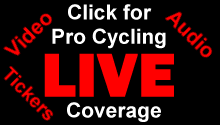

|
|
Thursday, January 17, 2008
Inside the Adobe Tour Tracker
An interview with Allan Padgett, Adobe by Pete Geyer, cyclingfans.com 
Allan Padgett, Adobe Paris - (cyclingfans.com) If you've used Adobe's
Tour Tracker to follow the Tours of California, Georgia and/or Missouri, chances
are that's not the only software application created by Adobe's Allan Padgett
that you're familiar with. Padgett is also the man behind the original
Windows versions of Adobe Acrobat and Reader. In fact, Padgett played
a key, pioneering role in getting the PDF file format accepted as a browser
plug-in back at a time when HTML pages and embedded images were the only
native formats recognized. Today, the very many users who publish information
in PDF format include organizers of bike races.
Padgett, a senior computer scientist at Adobe, joined the company in 1993. He developed Acrobat and Reader through version 3 and as part of that effort suggested a PDF plug-in architecture to Netscape CEO Jim Clark. The rest, as they say, is history. Padgett left Adobe to start his own company but returned after several years and has since worked on Acrobat 8 as well as small parts of Photoshop, In Design, and Illustrator. Adobe is one of the sponsors of the Amgen Tour of California which includes building the Tour Tracker. Adobe maintains ownership of the Tracker and is looking to see it used increasingly in other races. To that end, Padgett recently came to Paris to explore the possibility of the Tour Tracker seeing service with a certain race here in France. Padgett has also asked us once again to solicit Tour Tracker feedback from you, our readers. And with the 2008 Tour of California starting just one month from today, we thought we'd find out more about the Tour Tracker, including the latest developments... cyclingfans.com: So how did the creator of
Adobe Acrobat/Reader for Windows happen to get involved in creating the
Tour Tracker?
Allan Padgett: Adobe has been a sponsor of the Tour of California since its inception, and each year has designed the live online experience for the race. For 2006, the acquisition of Macromedia meant we had a powerful set of tools to use: Flash and Flex. I had just finished the visual redesign of Reader for version 8.0 and, actually, just happened to be sitting near the folks who were going to do the visuals for the 2006 race. Having seen a parade of road bikes leaning against my desk, they asked if I could spend a month doing the engineering for the application. The timing was perfect. CF: What has the experience of creating the Tour Tracker meant to you personally as well as to Adobe? AP: To Adobe, it has shown the world that Flash and Flex can produce online experiences that were nearly impossible before. It has become one of the "showcase" applications that are shown to audiences around the world. The fact that it was built in under a month with just a pair of engineers (we had the use of a wicked server-side guy named Christophe Coenrats) makes the story even better. One that competing technologies haven't even tried to challenge. Yet. Personally, it was a dream come true. Cycling is one of my passions and software development, fortunately, is not just a job for me, but a passion as well. To work closely with the folks that run a major race, push the edge of what has been done (often too far), and, most importantly to me, provide other fans with a better online experience... A combination that can't be beat! Oh, and Bob Roll and Paul Sherwin told me they loved it! CF: Are you a big pro cycling fan yourself? AP: I'd say medium-sized. I love to ride and, weather permitting, get around 125 miles a week in. I also have a disease, like many, where I seem to collect more bikes than I can ride at once. They do, however, all get ridden regularly! As for the pro races, I definitely keep tabs on the bigger ones and had the joy of chasing the Tour around France a few years ago, climbing as many of the big climbs as possible. And then randomly sitting with Lance's mom on the way home. We talked about where to get good BBQ in Dallas mainly. CF: What was the development process for the Tour Tracker? AP: The designs were originally done using Photoshop and Fireworks. These were done by a great designer named Dave Nelson and gave us a static view of what the Tracker should look like. Then, like almost every application ever built, the engineer went about destroying the designer's vision. Not intentionally, of course, but as the reality of bandwidth (both mine and the data we were showing) hit home, things changed a fair amount. Flex Builder was the workhorse here. It allows such amazingly quick development. The Tracker was my first Flash/Flex application - and it shows in some places - and the fact that it actually worked as well as it did is a testament to the sweet work that the Macromedia Flex team has done. CF: What do people seem to like the most about Tour Tracker? AP: Number one is simply that it was the only way for most people to see anything compelling about the race. There was effectively zero live TV coverage I think for 2006, so having a live feed was great. The GPS data certainly had the biggest cool factor, although I wish Levi (Leipheimer) would have stopped throwing his GPS device in the bushes. The combination of everything, however, is what has made it news. CF: What's the biggest gripe people have? AP: No question: quality of service. That is, it was great when it worked, but the percentage of time all of the feed (video, audio, play-by-play, GPS) were working at once must have been single digit! In our defense, both the video and GPS systems were completely untested beta services provided by other companies. I think the Tracker itself showed the video and GPS whenever it was actually available, but from the fan's perspective, that doesn't mean squat. CF: Can you explain how race video gets from the road to a viewer's browser? AP: I think so. First there is this dude sitting backwards on a motorcycle - wait, I'm going to find the diagram we did that shows the whole Tracker solution - it's crazy. (See graphic below) Anyway, this dude is filming the action. His camera is beaming the video up to an airplane flying around above the riders (thus the lack of video during inclement weather). That plane then sends the video up to satellite and then from there down to a truck where the production is done. For 2006, a separate truck took a feed from them, converted it to a Flash video stream, and sent it over a satellite connection up to a "content distribution network" (CDN) such as Akamai. Finally, the Tracker itself has a magic URL that it uses to connect to the CDN and stream the Flash video to the browser. Pretty much any single part of this can (and did) fail and make all the other parts useless. Tour of California Tracking System Architecture
CF: Any new features planned for 2008 you can talk about? AP: Definitely. I can't promise what will make it in because, honestly, our primary focus is quality of service. Heck, if the Tracker just worked 24/7 it would be like a whole new application! But, the list includes: fan chat rooms (did this in Georgia and it was a big hit), multiple video streams that the user can switch between, detailed information on who is in any break-aways, low-bandwidth versions of the mapping component, fan-generated media (think cell phones along the route!), and more. Importantly, the Tracker will also be available as a desktop application (using Adobe's "AIR" technology) that will have more features than just going to the website. We have already done lots to improve the video quality at all points of the problem. Most importantly, the primary video feed will be coming straight from the satellite, so if it is available to anyone, we will have it. The application itself is also super robust now should the video upstream get dropped for a time. For GPS, we will be tracking all 100+ riders, although each user will be able to select which riders they want to follow. By default that will be the top riders in each category (GC, sprint, KOM) plus any riders that are in a break away. Also a chance I will have time to implement some version of “fantasy cycling” where each viewer can choose a team for the duration, and the winners will get schwag from the Tour… CF: Sounds ever more ambitious! How about a status window where you keep viewers informed of video status, audio status, etc.? For example: "Audio: Tour Tracker is currently not receiving any audio from the race." (This would help answer the question no doubt most people have when they don't hear any audio: Should I be hearing audio?) AP: Will definitely add that. We did “alerts” about the status, but were pretty sporadic about it. CF: The Tour Tracker has seen service with the Tours of California, Georgia and Missouri. You recently came to Paris to meet with Tour de France officials. Any other races on the horizon for the Tour Tracker? AP: The Paris trip went great, but the Tour de France is not yet ready for the Tour Tracker. The Tour director wants to stay focused on the traditional Tour-watching experience – fans on the side of the road or in a pub I guess. Plus they (Tour organizer A.S.O.) are very hesitant to require riders to modify their bikes, particularily before the technology is well vetted in other arenas. Finally, they don’t even have the rights to the online video for many years to come as those rights are tied up in contracts for countries that have acquired online rights. On the upside, they would like to use the Tracker on some other races, and I’ve been contacted by one party that does have the video rights for some areas to see what we can do. Nothing firm yet… |
|